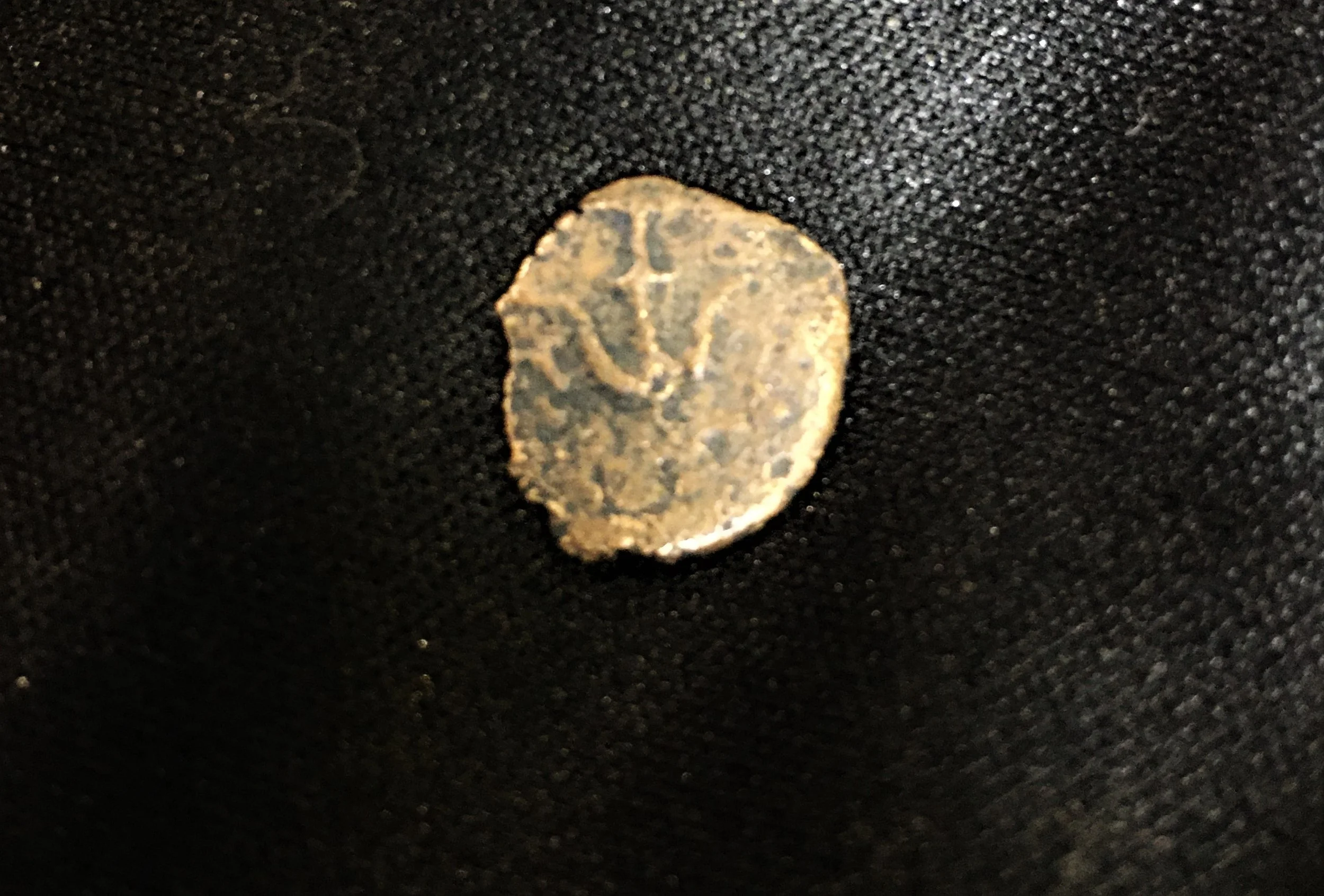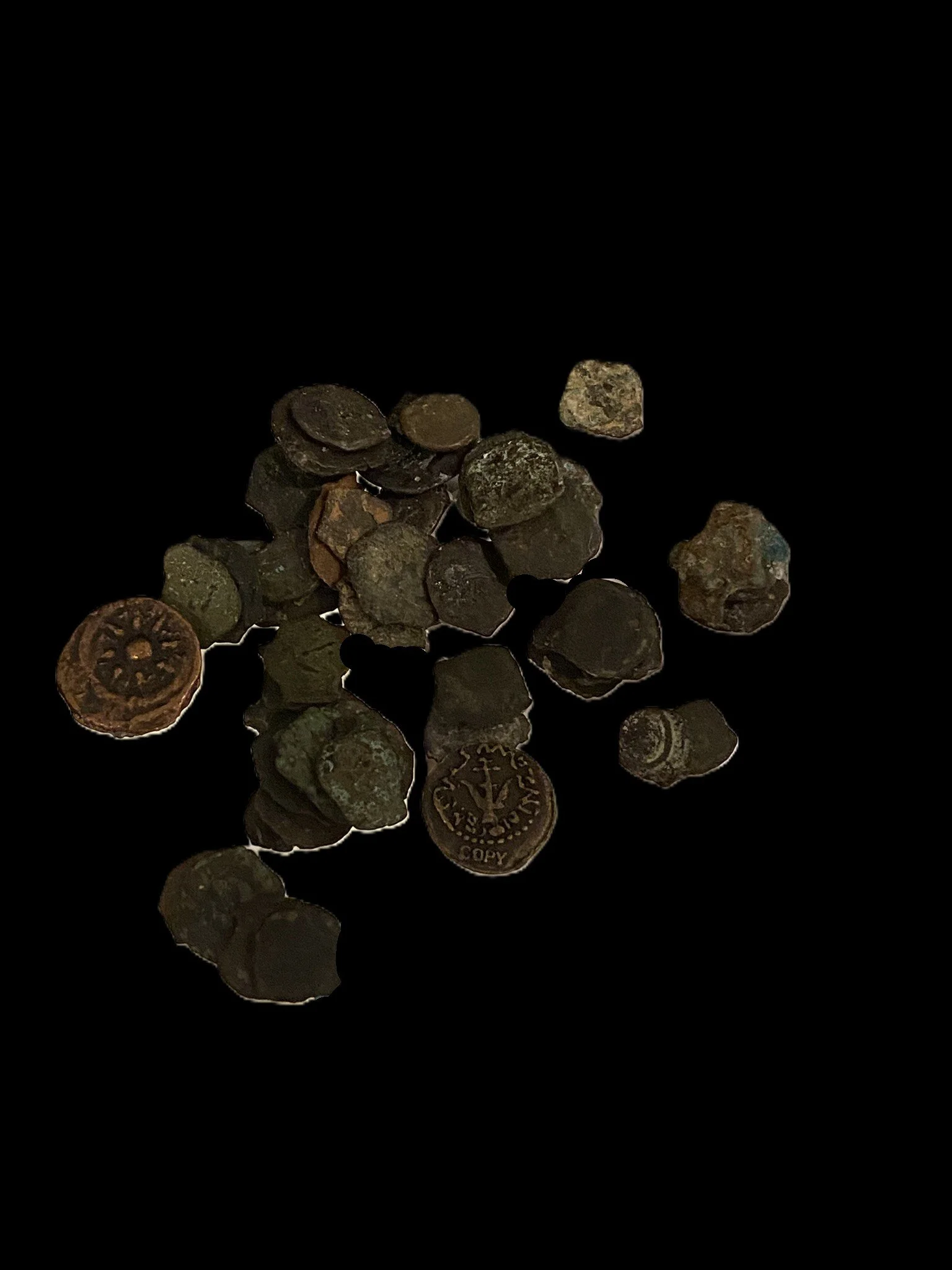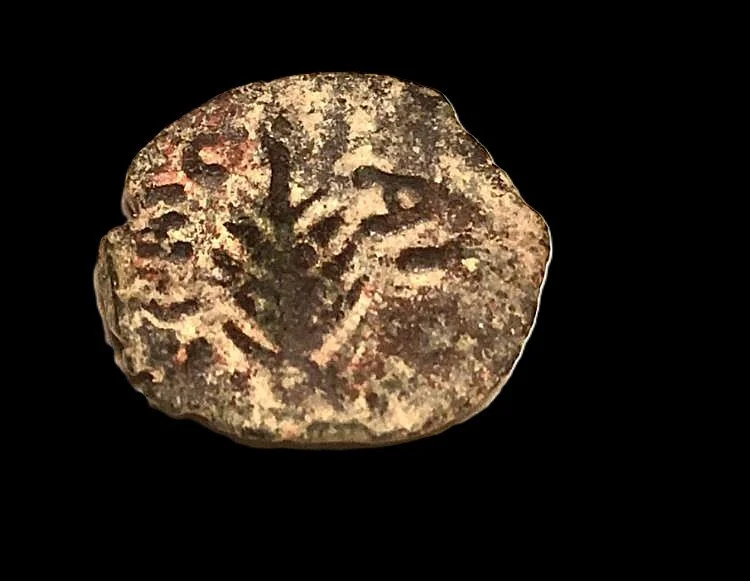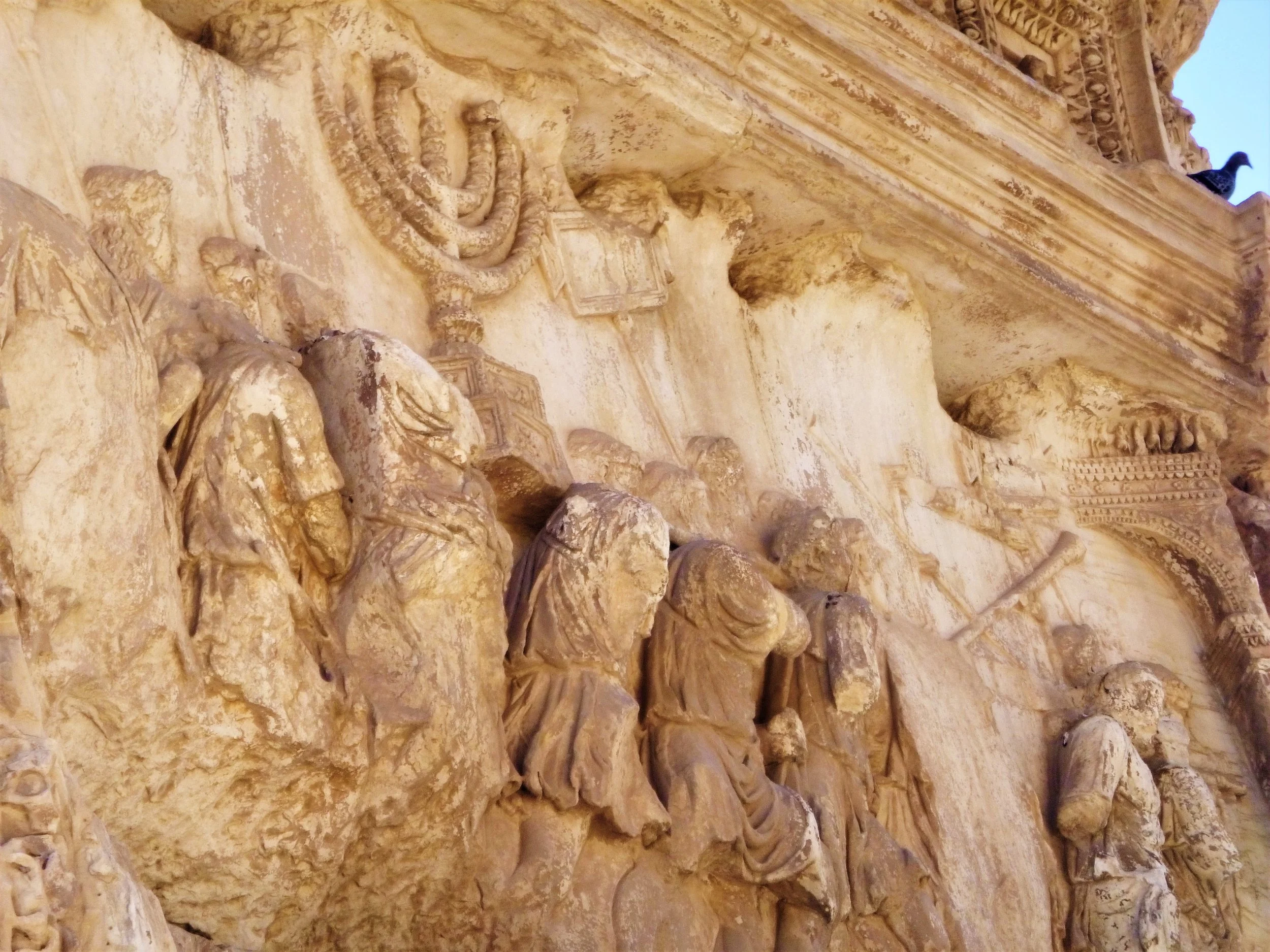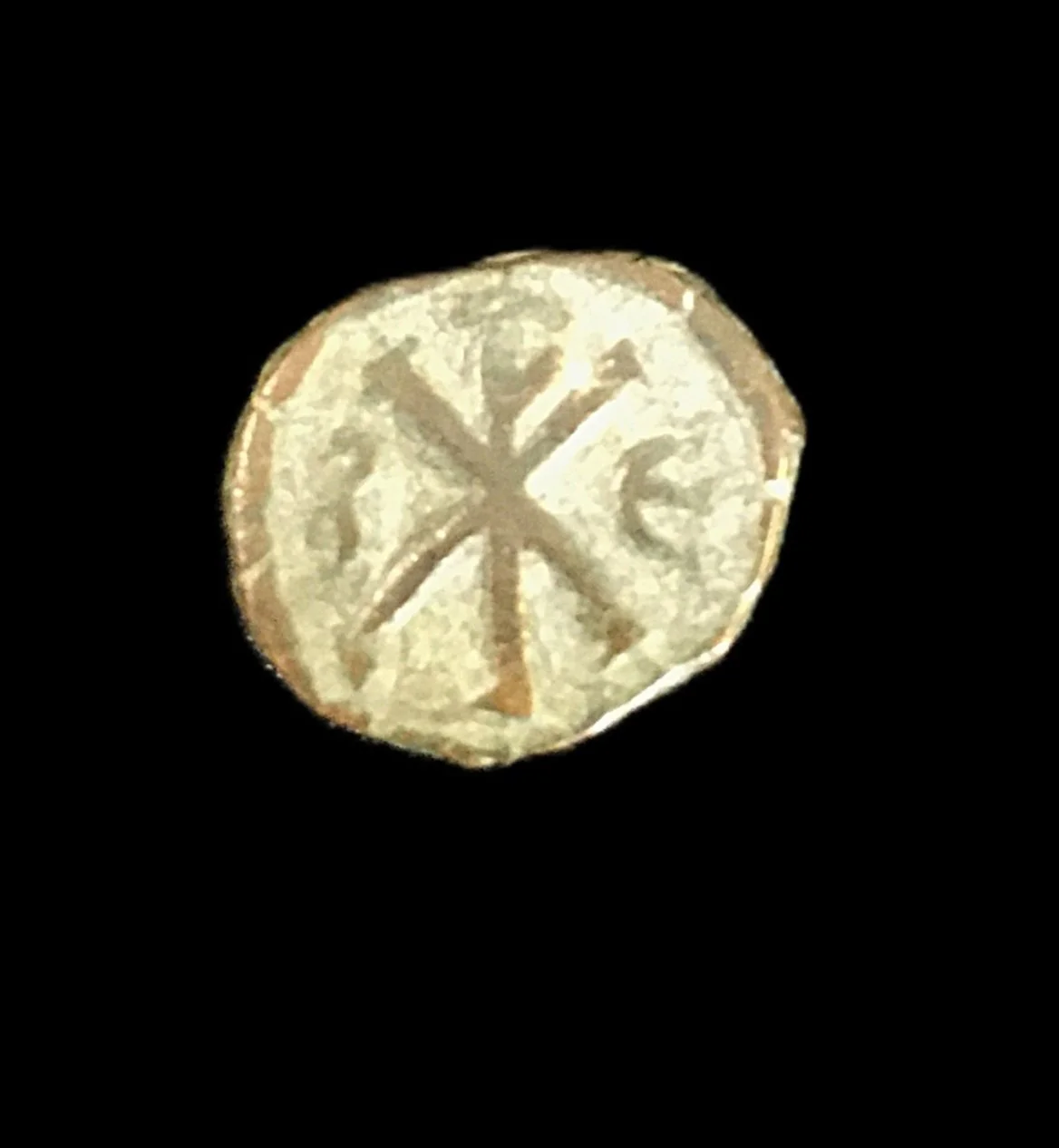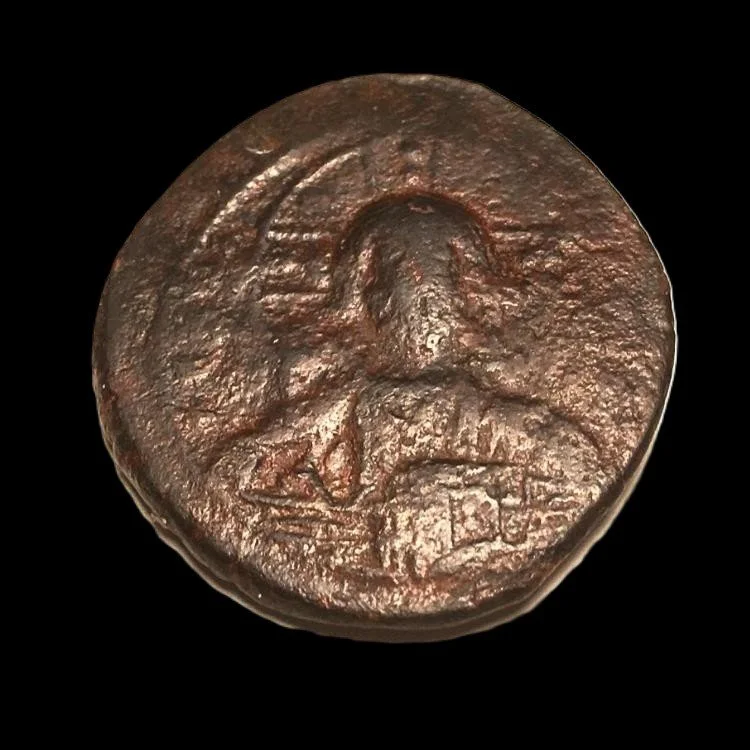Type: Coin of Xerxes I to Darius
Age: 485-420 BCE
Era: Persian
Culture: Persian
Excavated: Unknown
Reference: Wacks, M. (2021) The Handbook of Biblical Numismatics: 45th Anniversary Edition
The Persian King Ahasuerus (AKA Xerxes) has been long believed to be the king who put away Queen Vashti and replaced her with the Jewish Queen Hadassah (AKA Esther). This can be read in the book of Esther in the Bible, and discussed by the Jewish historian Josephus.
According to the seller, this coin has two banker marks punched into the obverse side of the coin.
Type: Alexander Jannaeus Prutah
Age: 135 BCE-37 CE
Era: Hasmonian and Roman
Culture: Hasmonian
Excavated: Unknown
Purchased:
Reference: Wacks, M. (2021) The Handbook of Biblical Numismatics: 45th Anniversary Edition
This coin has long been referred to as the Widows Mite.
“Truly, I tell you, this poor widow has put in more than all of them. For they all contributed out of their abundance, but she out of her poverty put in all she had to live on.”
Luke 21: 1-4
Type: Azilizes Coin
Age: 35 BCE-5 AD
Era: Roman
Culture: Scythian
A silver coin minted in the kingdom of Baktria depicting King Azes II on horseback following a star with the inscription “King from the East” (of Bethlehem). Was this one of the Three Wise Men of the Bible?
Type: Antiochus VII Sidetes Silver Tetradrachm (Tyrian Shekel)
Age: 130-129 BCE
Era: Hellenistic/Selukid
Culture: Selukid
Reference: Wacks, M. (2021) The Handbook of Biblical Numismatics: 45th Anniversary Edition
This is the coin used for the Temple Tax during the second temple period.
For Christians, this coin is considered blood money. The Tyrian shekel would have been used for the thirty pieces of silver given to Judas for his betrayal of Jesus.
14 Then one of the Twelve, the one called Judas Iscariot, went to the chief priests 15 and asked, “What are you willing to give me if I hand Him over to you?” And they set out for him thirty pieces of silver.
Matthew 26:14-15.
"However, so that we do not offend them, go to the sea and throw in a hook, and take the first fish that comes up; and when you open its mouth, you will find a shekel. Take that and give it to them for you and Me.”
Matthew 17:27 NASB
Type: Coin minted by Pontius Pilate
Age: 26-36 CE
Era: Roman
Culture: Roman
Purchased: United Arab Emirates
Reference: Wacks, M. (2021) The Handbook of Biblical Numismatics: 45th Anniversary Edition
This is one of the most common coins minted by, and in circulation during the time of Pontius Pilate in Judea. Tiberius was the Roman Emperor who reigned from 14-37 CE during the times of Pontius Pilate and Jesus. Tiberius was the second Roman Emperor taking the reign from Augustus, adopted son of Julius Caesar. The left register of the coin reads TIBEPIOY and the right register should read KAICAPOC, meaning Tiberius emperor). This coin typically has one of three dates marked on the back LIS=Year 29,LIZ=year 30, and LIH=year 31. The date on this coin is corroded
For those interested, certain scientists believe that they found images of this coin placed over the eyes of the individual depicted on the Shroud of Turin.
Type: Porcius Festus Coin
Age: 60-62 CE
Era: Roman
Culture: Roman Judea
Reference: Wacks, M. (2021) The Handbook of Biblical Numismatics: 45th Anniversary Edition
Porcius Festus was the Judean Procurator that sent Paul to Nero in Rome.
Three days after his arrival in the province, Festus went up from Caesarea to Jerusalem, 2where the chief priests and Jewish leaders presented their case against Paul. They urged Festus 3to grant them a concession against Paul by summoning him to Jerusalem, because they were preparing an ambush to kill him along the way.
Acts 25:1-3
Type: Antonius Felix Coin
Age: 52-60 CE
Era: Roman
Culture: Roman Judea
Reference: Wacks, M. (2021) The Handbook of Biblical Numismatics: 45th Anniversary Edition
Antonius Felix was the Judean Procurator that imprisoned Paul in Caesarea Marittima.
When Paul had been called in, Tertullus opened the prosecution: “Because of you, we have enjoyed a lasting peace, and your foresight has brought improvements to this nation. 3In every way and everywhere, most excellent Felix, we acknowledge this with all gratitude. 4But in order not to burden you any further, I beg your indulgence to hear us briefly.
Acts 24:2-4
Type: First Jewish Revolt Prutah Coin Year Two and Year Three
Age: 66-70 CE
Era: Roman
Culture: Judea
Reference: Wacks, M. (2021) The Handbook of Biblical Numismatics: 45th Anniversary Edition
These coins were minted by Jewish Rebels who were seeking their independence from Rome.
Jesus predicted that the Temple was going to be destroyed with no “stone standing upon another.” About 40 years later their was a Jewish rebellion against their Roman overlords, led by the Zealots. Roman General Vespasian brought the force of the Roman military down on Israel, laying a scene of destruction from the north to the south. Vespasian left the war to his son Titus, so he could return to Rome to become Emperor. In 70 AD, Jerusalem was destroyed and the temple razed to the ground. The Romans then set their eyes on Masada, which was the last stronghold of the Zealots.
Stones thrown down from the Temple Destruction of 70 AD
Roman military camp at the base of Masada.
Roman siege ramp leading to the top of Masada.
Arch of Titus in Rome showing some of the items taken from the Jerusalem Temple.
Type: Caesar Vespasian Judea Capta Denarius (Rome Mint)
Age: 69-70 CE
Era: Roman
Culture: Roman
Reference: Wacks, M. (2021) The Handbook of Biblical Numismatics: 45th Anniversary Edition
This coin was minted to commemorate Romes victory over the Jewish rebels of the First Jewish Revolt; hence the name Judea Capta which is printed on the coins. One can see the letters IVDA on the reverse side of this coin. This refers to Judea.
Vespasian AR Denarius. Rome Mint 69-70 AD. "Judaea Capta" issue. Obverse: IMP CAESAR VESPASIANVS AVG, laureate head right. Reverse: Judaea seated right, in attitude of mourning, to right of trophy, resting head on left hand, IVDAEA in exergue. This is the famous denarius commemorating the re-captivity of the Judean province!
There are larger replica’s of the Judea Capta coins in the case as well. These coins were minted to celebrate the capture of Jerusalem, Judea, and the destruction of the Jerusalem Temple. There are several variants of the coinage. The reverse of the coins show a Jewish female (representing Judea) seated right, in an attitude of mourning, at the base of a palm tree, with either a captive Jewish male standing right, with his hands bound behind his back, the standing figure of the victorious emperor, or the goddess Victory with a trophy of weapons, shields, and helmets.
The female figure may reflect the prophecy of Isaiah, 3:8; 25-26, “For Jerusalem is ruined, and Judah is fallen…thy men shall fall by the sword and the mighty in the war. And her gates shall lament and mourn, and she being desolate shall sit upon the ground.”
Type: Justin I
Age: 518-527 CE
Era: Byzantine
Culture: Byzantine
Reverse has the Chi Rho, the Christogram used in the early church to secretly identify oneself as a Christian. Chi Rho are the first two letters of Christos or Christ, which is Greek form of Messiah (Hebrew). Once Christianity became a sanctioned religion in the Roman Empire, secrecy was no longer needed
Type: Justinian I Bronze Pentanummium E
Age: 527-565 CE
Era: Byzantine
Culture: Byzantine
Purchased: David Connor Ancient Coins & Artifacts
Reference:
Justin I (above) was, for the most part, a beloved Christian Emperor; but his nephew and heir to the crown, Justinian I, was a wretch of a person. The historian Procopius, who was Justinian's biographer, wrote two histories of Justinian. One history was published during the life of Justinian and the other after the death of Procopius (the author). The latter was called the "Secret History," and served as a tell-all novel of depravity and corruption.
Excerpt from the Secret History: "Of the plundering of property or the murder of men, no weariness ever overtook him [Justinian]. As soon as he had looted all the houses of the wealthy, he looked around for others; meanwhile throwing away the spoils of his previous robberies in subsidies to barbarians or senseless building extravagances. And when he had ruined perhaps myriads in this mad looting, he immediately sat down to plan how he could do likewise to others in even greater number."
Type: Byzantine Coin with Jesus on front (Struck under Basil II and Constantine VIII)
Age: 976-1025 CE
Era: Byzantine
Culture: Byzantine/Roman
Reverse reads: IhSЧS / XPISTЧS / bASILЄЧ / bASILЄ (Jesus Christ King of Kings) in four lines
Type: Replica of a Bar Kokhba Revolt coin
This is a replica of a coin minted during the Simon Bar Kokhba Revolt against the Romans in 134 AD. The Harp was invented by Jubal (Genesis 4:21) and was the national instrument of the Hebrews. Some think that the word kinnor denotes the whole class of stringed instruments. It was used as an accompaniment to songs of cheerfulness as well as praise to God (Genesis 31:27; 1 Samuel 16:23, 2 Chronicles 20:28; Psalms 33:2; 137:2).
Around 118 AD, the Roman Emperor Hadrian allowed the Jews to return to Jerusalem after their last revolt in 66 AD. He even granted them permission to rebuild the Temple. Unfortunately, Hadrian changed his mind which led to a major Jewish rebellion led by Shimon Bar-Kokhba.
Type: Replica of the Tiberian Denarius
An ancient silver Roman denarius or tribute penny mentored under the emperor Tiberius (15-18 AD). The front shows a fine portrait of emperor Tiberius facing right and wearing a Laurel wreath. The reverse has the wife of Augustus (Empress Livia) in the guise of the goddess of peace, “Pax.” She is shown seated on a chair with ornate legs, resting her right hand on a tall scepter And holding out an olive branch with her left hand.
The legend reads: PONTIF [ex] MAXIM [vs]-“Chief Priest.” This coin is often referred to as the “tribute penny” due to its Biblical connection. In Matthew 22:21 of the New Testament Jesus was asked whether Jews should pay tribute tax to Cesar. His famous response was; “Show me the coin used for paying the tax.” They brought him a denarius and he asked them, “Whose image and inscription is this?” “Caesar’s,” they replied. Then he said to them, “Render unto Caesar the things which are Caesar’s, and unto God the things that are God’s.” It is widely accepted that the denarius handed to Jesus in this passage would have been the present type.

